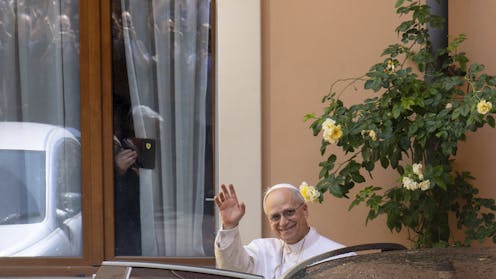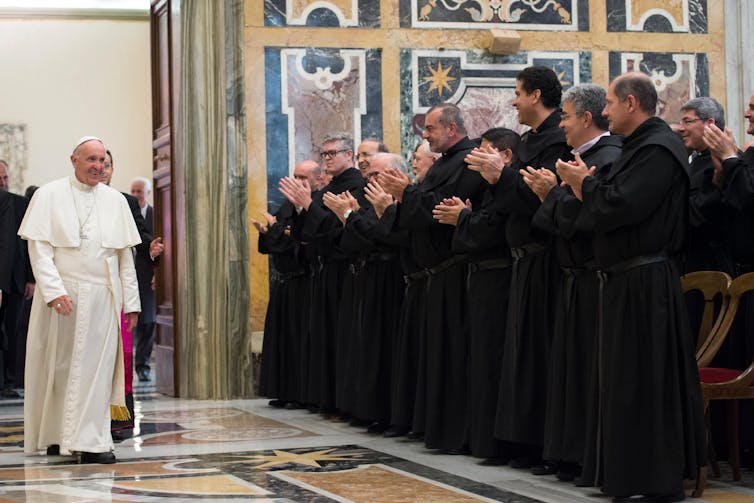Pope Leo XIV is the first member of the Order of St. Augustine to be elected pope – but who are the Augustinians?
- Written by Joanne M. Pierce, Professor Emerita of Religious Studies, College of the Holy Cross
 Pope Leo XIV leaves the Augustinian General House in Rome after a visit on May 13, 2025.AP Photo/Domenico Stinellis
Pope Leo XIV leaves the Augustinian General House in Rome after a visit on May 13, 2025.AP Photo/Domenico StinellisWhen Pope Leo XIV was elected pope, the assembled crowd reacted with joy but also with surprise: He was the first pope from the United States, and North America more broadly. Moreover, he was the first member of the Order of St. Augustine to be elected to the papacy.
Out of all 267 popes, only 51 have been members of religious orders. Pope Francis was elected in 2013 as the first member of the Jesuit order, the Society of Jesus; he was also the first member of any religious order to be chosen in over 150 years.
As a specialist in medieval Christianity, I am familiar with the origins of many Catholic religious orders, and I was intrigued by the choice of a member of the Order of St. Augustine to follow a Jesuit as pope.
So, who are the Augustinians?
Early monks and concern for community
In antiquity, some Christians chose to lead a more perfect religious life by leaving ordinary society and living together in groups, in the wilderness. They would be led by an older, more experienced person – an abbot. As monks, they followed a set of regulations and guidelines called a “monastic rule.”
The earliest of these rules, composed about the year 400, is attributed to an influential theologian, later a bishop in North Africa, called St. Augustine of Hippo. The Rule of St. Augustine is a short text that offered monks a firm structure for their daily lives of work and prayer, as well as guidelines on how these rules could be implemented by the abbot in different situations. The rule is both firm and flexible.
The first chapter stresses the importance of “common life”: It instructs monks to love God and one’s neighbor by living “together in oneness of mind and heart, mutually honoring God in yourselves, whose temples you have become.”
This is the overriding principle that shapes all later instructions in Augustinian rule.
For example, Chapter III deals with how the monks should behave when out in public. They should not go alone, but in a group, and not engage in scandalous behavior – specifically, staring at women.
If one monk starts staring at a woman, one of the other monks with him should “admonish” him. If he does it again, his companion should tell the abbot first, before any other witnesses are notified, so that the monk can try to change his behavior on his own first, so as not to cause disruption in the community.
Because of this clarity and flexibility, its concern for both the community and the individual members, many early religious communities in the early Middle Ages adopted the Rule of St. Augustine; formal papal approval was not required at this time.
Mendicant friars in medieval Europe
By the end of the 12th century, Western Europe had become much more urbanized.
In response, a new form of religious life emerged: the mendicant friars. Unlike monks who withdrew from ordinary life, mendicants stressed a life of poverty, spent in travel from town to town to preach and help the poor. They would beg for alms along the way to provide for their own needs.
The first mendicant orders, like the Franciscans and Dominicans, received papal approval in the early 13th century. Others were organized later.
A few decades later, several hermits living in the Italian region of Tuscany decided to join together to form a new mendicant order. They chose to follow the Rule of St. Augustine under one superior general; Pope Innocent IV approved the new order as the Order of Hermits of St. Augustine in 1244. Later, in 1254, Pope Alexander IV included other groups of hermits in the order, known as the Grand Union.
The new order grew and eventually expanded across Western Europe, becoming involved in preaching and other kinds of pastoral work in several countries.
Early missionaries to modern times
As European countries began to explore the New World, missionary priests took their place on ships sent from Catholic countries, like Spain and Portugal.
Augustinians were among these early missionaries, quickly establishing themselves in Latin America, several countries in Africa and parts of Southeast Asia and Oceania, arriving in the Philippines in the 16th century.
There, they not only ministered to the European crews and colonists, but they also evangelized – preached the Christian gospel – to the native inhabitants of the country.
Augustinian missionaries started the process of setting up Catholic parishes and, eventually, new dioceses. In time, they founded and taught in seminaries to train native-born men who wanted to join their order.
It wasn’t until the end of the 18th century that Augustinian friars arrived in the United States. Despite many struggles and setbacks in the 19th century, they established Villanova University in Pennsylvania and other ministries in New York and Massachusetts. Except for two 17th-century missionaries, Augustinian friars didn’t arrive in Canada until the 20th century, when they were sent from the German province of the order to escape financial pressure from the economic depression of the 1920s and political pressure from the Nazis.
 Pope Francis meets with members of the Order of Augustinian Recollects at the Vatican on Oct. 20, 2016.L'Osservatore Romano/Pool Photo via AP
Pope Francis meets with members of the Order of Augustinian Recollects at the Vatican on Oct. 20, 2016.L'Osservatore Romano/Pool Photo via APToday, there are some 2,800 Augustinian friars in almost 50 countries worldwide. They serve as pastors, teachers and bishops, and have founded schools, colleges and universities on almost every continent. They are also active in promoting social justice in many places – for example, in North America and Australasia, comprising Australia and parts of South Asia.
Based on his years as a missionary and as provincial of the entire order worldwide, Leo XIV draws on the rich interpersonal tradition of the Order of St. Augustine. I believe his pontificate will be one marked by his experiential awareness of Catholicism as a genuinely global religion, and his deep concern for the suffering of the marginalized and those crushed by political and economic injustice.
Joanne M. Pierce does not work for, consult, own shares in or receive funding from any company or organization that would benefit from this article, and has disclosed no relevant affiliations beyond their academic appointment.
Authors: Joanne M. Pierce, Professor Emerita of Religious Studies, College of the Holy Cross

